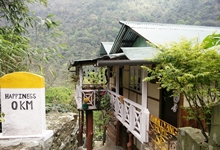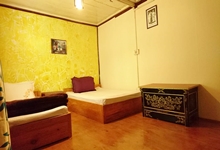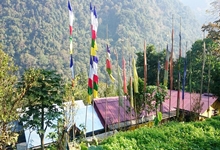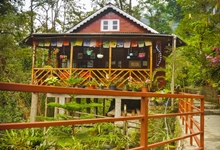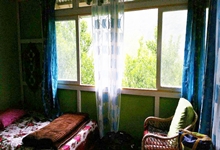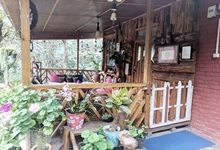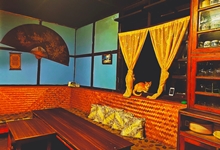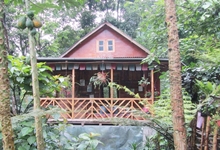
DZONGU
Dzongu is a triangular region and a tourist’s destination situated in the northern part of Indian state of Sikkim in Mangan sub division. Dzongu is mainly a culmination of villages and is bounded by River Teesta in the south-east, River Tholung Chu is the north-east and the mighty Himalayas in the west. Dzongu is established as an old habitat of the Lepcha People (the aboriginal inhabitants of Sikkim). The Lepcha community at Dzongu lives with their own tradition, culture and heritage in complete harmony with nature. A part of Dzongu valley borders Kangchendzonga Biosphere Reserve. Dzongu is nestled at an altitude that varies from 800 meter to 6000 meter (2625 feet to 19685 feet). Dzongu is mainly divided into two parts namely Upper Dzongu and Lower Dzongu. The region of Dzongu is characterized by abruptly rising mountains, small villages, curvy roads guarded with canopies of green bamboo shoots along with cardamom, rice and potato plantations. The main source of livelihood of the local inhabitants of Dzongu is farming through step cultivation or terrace farming. But recently with the inception of tourism some of these local villagers have started renting their houses for accommodating tourists in homestay basis. Dzongu consists of sparsely populated small villages scattered around the mountains with thick canopy of forests, reverberates with the symphony of Himalayan birds and serenity all over. Dzongu is untrammelled by tourist rush and mostly covered with dense natural vegetation along with rice and cardamom fields around the villages. On a clear day Dzongu offers captivating view of the snow – capped Himalayan ranges of the eastern Himalayas. Apart from the Himalayan range of Mt. Kangchendzonga, Dzongu also offers clear view of other Himalayan peaks of Simhu Twins, Sinilocha, Talung, Pamdim, Kabru and Jopuno. At Dzongu tourists can experience life at its most natural form as the local inhabitants of Dzongu depends entirely on nature and lead a self – sustained life. With all of these characteristics, Dzongu is indeed heavenly paradise for adventure and solitude seekers. Dzongu is not considered as a typical hill resort rather it is a completely isolated hamlet from the rest of world. Dzongu is mainly an undisturbed land where tourists can experience nature at its purest form and nurture lifetime bonds with simple and hospitable Lepchas of the region.
Attractions (places of visit) around Dzongu:
Being an isolated village and an off-bit tourist destination, Dzongu offers tourists with handful of attractions all around. Dzongu comprises of several villages those are crisscrossed by perennial streams and mountain valleys which are worth visiting.
- Passindang Village: This village serves as a base for stay at Lower Dzongu valley. Here at Passindang village tourists will gain an insight into the customs and traditions of these native Lepcha people of Dzongu. Here at Passindang village tourists are welcomed with Chang (local country liquor prepared from millets and Khabze a snacks delicacy).
- Lingdong Village: Lingdong village is also located at Lower Dzongu. Lingdong village is mainly known as the centre of handicrafts at Dzongu. Here the local inhabitants make bags, carpets, hats, mats and other craft items those are made from the locally available products. Here at Lingdong village tourists can opt to buy some local handicraft items for decoration.
- Hee Gyathang Village: Hee Gyathang village is located at Lower Dzongu and is mainly known for a lake situated at this village which is considered sacred by the Lepchas. Apart from that there is a monastery in this village named as Hee Gyathang Monastery which can only be reached by hiking from Lower Dzongu.
- Lingthem Village: Lingthem Village is located at Upper Dzongu and it can be reached by trekking from Passindang Village through Bamboo forest and step cultivation fields. Lingthem Village at Dzongu offers stunning view of the mountain ranges on a clear day. Lingthem village is situated at the heart of the forest with lush greenery all around. There is a Buddhist Monastery at Lingthem Village where the Lamas follow Nyingma Buddhism. In the month of December this monastery organises mask dance festival.
- Lingzya Falls: Lingzya or Lingzey waterfall is located at Upper Dzongu. From Passingdang village on the way to Pentong village tourists can witness Lingya waterfall. This majestic waterfall has a drop of 250 feet high and at the base of this waterfall a small natural pond has formed. River Tholung at Dzongu is the source of this waterfall and one need to cross a cantilever bridge to reach near the waterfall.
- Pentong Village: Pentong is one of the last inhabited villages of Dzongu which is quiet close to the mountain peaks. The route to Pentong village of Dzongu is through the dense greenery and spectacular cliffs. The area of Pentong village is relatively flat ground. There are two hillocks seen at Pentong village of Dzongu which are named as Tarbi and Tarbot. Tarbi is referred as a local deity and Tarbot a demon. To the opposite of Pentong village another Lepcha inhabited village named Sakyong is seen.
- Tholung Monastery: Tholung Monastery is nestled at Upper Dzongu in the buffer zone of Khangchendzonga National Park and is set at an altitude of 8000 feet and is serves as a resting point for trekkers on their way to Kusheong Valley. The trek to Tholung Monastery starts from Lingthem village and is around 18 – 20 km long. Tholung Monastery is considered to be one of the most sacred of this region. Tholung Monastery is a treasure trove of the holy artefacts, religious scriptures, precious collections and invaluable write-ups of the former Lamas and Chhogyals those were brought here from other gompas in order to protect from the Nepalese invasion during the end of 17th century and beginning of the early 19th century. Every three years these artefacts are taken out from the monastery for public display during Kamsil Ceremony.
- Tingvong Village: Tinvong village is nestled at Upper Dzongu and can be easily reach by road. Tingvong Village is located on the gentle slopes overlooking the vast mountain ranges and deep valleys. During winter the village gets covered with thick blankets of snow.
- Kusong Village: Kusong is another small Lepcha inhabited village at Upper Dzongu. From Tingvong village a walk of 45 minutes will reach at Kusong village. Kusong village consists of very few hamlets and tourists can witness terraced farming all around the village. There is a monastery located nearby which is worth visiting.
- Traditional House at Namprikdang: A Lepcha traditional House now converted into a museum is located at Namprikdang, Dzongu. This Lepcha House is located at a short drive from Passingdang village and one of unique feature of this old house is that it displays the ingenuity of an age old tradition. This Lepcha House is a super structure set on an open surface over stone slabs to counter the effects of powerful earthquakes. From this Lepcha House a walk of 05 minutes tourists can witness the confluence of River Rongyung Chu and River Teesta.
- Keushong: Keushong valley can be reached from Dzongu by 03 to 04 days trekking. Keushong Valley trek is relatively a difficult trek and at the setting of the valleys lays Keushong Lake. Keushong is probably the most pristine place in Dzongu and the spot is covered with hills and mountain valleys all around. The right side of Keushong Valley is covered with flowers and lush greenery.
Activities around Dzongu:
Tourists visiting Dzongu can opt to take part in wide arrays of activities around the valley. Some of which are described below.
- Trekking: Several trekking and hiking trails emerge from Dzongu those meet up at different parts of the village. Though trekking is the most common option to visit other spots around Dzongu village. While trekking through these trails, one will encounter with untouched forests and streams. A vast virgin territory of Dzongu valley can be explored by trekking.
- Village walks: Tourists visiting Dzongu can opt for a leisure walk all around the several villages of Dzongu valley. During leisure village trails tourists can meet the local Lepcha people and get a deep insight of their day to day lifestyle.
- Adventurous Cane Bridge Crossing: The local Lepcha people build hanging cane bridges across the rivers all around Dzongu Valley and tourists need to cross these bridges in order to reach one spot from the other and are an experience worth remembering.
- Observe Nature: Dzongu valley is a treasure trove for nature enthusiasts. The surrounding natural landscape along with wide availability of Himalayan birds, butterflies and natural vegetation are worth admiring. All around Dzongu valley numerous species of flowers and herbs are seen which are mostly used for medicinal purposes. Apart from that 05 different species of Rhododendrons are found around Dzongu Valley.
- Cultural Programs: The local Lepcha people at Dzongu valley take pride in displaying their traditions, customs and culture to the tourists. In the evening one can take part in observing the local folk songs and dances performed by these Lepcha people at Dzongu.
- Pilgrimage visit: As Dzongu valley is a completely Lepcha inhabited village hence tourists will find numerous small and big Monasteries and Buddhists Chortens all around the valley at different villages. Some of these Monasteries are very renowned and are highly revered.
- Mountain Biking: Tourists with an adventurous bend of mind can try mountain biking along the hilly terrains of Dzongu valley.
- Hot Spring visit: There is a hot spring mixed with sulphur located at Lingdem village of Lower Dzongu. The locals of Dzongu believe that the hot spring have medicinal qualities and healing powers.
How to reach:
By Air: Bagdogra Airport (IXB) in West Bengal is the nearest airport to Dzongu in North Sikkim located at a distance of 160 km away. From Bagdogra Airport by hired vehicles either via Gangtok or via Singtam tourists can reach at Dzongu. From Bagdogra Airport at a distance of 123 km away is Gangtok and 100 km away is Singtam located.
By Train: New Jalpaiguri (NJP) railway station is the nearest rail head to Dzongu located at a distance of 155 km by road. NJP railway station is well connected by good railway networks with Kolkata and other major cities of India. From NJP railway station by hired vehicles either via Gangtok (119 km) or via Singtam (96 km) tourists can reach Dzongu.
By Road: Dzongu is well connected by road with Siliguri (148.7 km via NH10), Gangtok (76 km), Singtam (49 km) and Mangan (17.5 km). From Bagdogra Airport/ NJP Railway station tourists can opt for shared vehicles upto Gangtok/ Singtam/ Mangan and from there by another vehicle tourists can reach upto Dzongu. From Vajra Taxi stand at Gangtok vehicle services are available to reach Dzongu. Or another option is to reach Mangan and get-off in the main market area and from here exclusive vehicles are available upto Dzongu. Mangan is only 10 km away from Lower Dzongu.
Permit to visit Dzongu:
Dzongu being a restricted area hence tourists are required to obtain the required permits before entering Dzongu. The permits are usually issued from Mangan. Several tour operators are available at Mangan those can make the permits or tourists can also obtain the permits from STDC office at Mangan.
Things to Know:
- Dzongu is a Lepcha inhabited village and a protected area, hence tourists are advised to respect their traditions, cultures and customs.
- Tourists are also advised not to litter around the village as Dzongu lies with the buffer zone of a biosphere reserve.
- In order to visit different parts of Dzongu valley/ different villages tourists are required to hire a proper guide from Dzongu those are locally available.
- For trekking and hiking to the higher altitude areas of Dzongu tourists are again advised to take an experienced guide and porter along with.
- Tourists are advised not to pluck any vegetables from the agricultural fields without prior permission from the locals. Neither tourists should pluck any leaves from the trees or tear any flowers. One should also not disturb the natural habitat of the area.
Best time of visit:
Summers and winters are the best time to visit Dzongu. The most ideal time is from February to May. Monsoon (June to September) is better avoided, as during this time heavy rainfall raises the risk of landslides along with that the make shift bamboo bridges over the rivers may get swayed away by rising water and the raging torrents of the river. During winter season most of the parts of Dzongu gets covered with snow. Summers are the best to escape the scorching heat and are also ideal for visiting different parts of Dzongu.
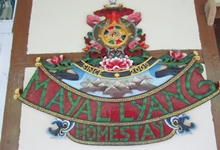

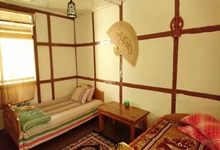



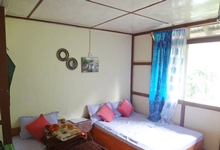
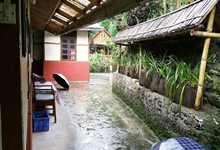
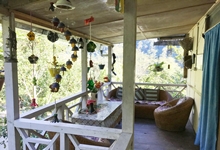


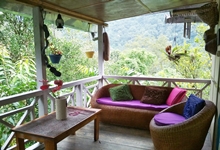
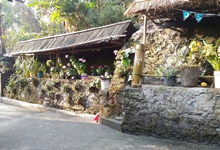
MAYAL LYANG HOMESTAY
Mayal Lyang Homestay at Dzongu is an eco-tourism venture started by a native Lepcha family of that region. Mayal Lyang Homestay is situated at Passingdang village of Lower Dzongu. At Mayal Lyang Homestay tourists can experience the warmth and hospitality of the Lepcha people at Dzongu. Mayal Lyang Homestay is nestled amongst the woodlands and lush greenery of the place. From Mayal Lyang Homestay within a short walk tourists can reach near Rongyung Chu River. A short walk around Mayal Lyang Homestay can make tourists experience the hidden treasures of Dzongu. The rooms of Mayal Lyang Homestay offers clear view of the snow-capped Himalayan ranges along with that one can also experience the ecology of the region. All the rooms of Mayal Lyang Homestay are very simple and wooden furnished. Foods served at Mayal Lyang Homestay are fully organic and garden fresh. Mayal Lyang Homestay also arranges for pick up and drop facility (both from Gangtok/ Mangan) for tourists. Mayal Lyang Homestay also arranges guides for tourists which are locally available.
Tariff:
INR @ 1650/- per day per person (both food and lodging included).
HOW TO BOOK: Call 9831311606 , 9830381306 and get the current rooms availability status or use the query form below. Or visit us at 8C Shanti Ghosh Street, Kolkata – 700003, near Manindra Chandra College. Or drop your query by Whats app in the above numbers.
